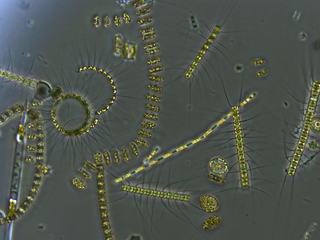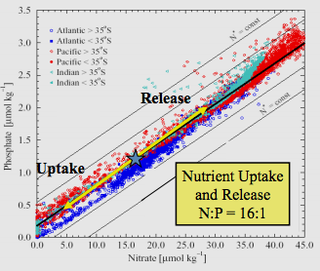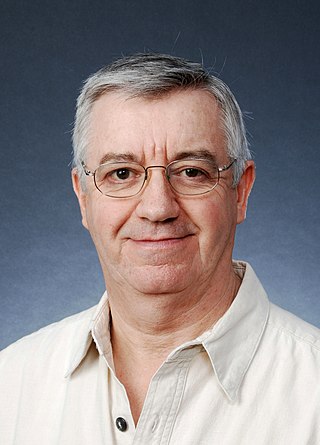Related Research Articles

Phytoplankton are the autotrophic (self-feeding) components of the plankton community and a key part of ocean and freshwater ecosystems. The name comes from the Greek words φυτόν, meaning 'plant', and πλαγκτός, meaning 'wanderer' or 'drifter'.

Landscape ecology is the science of studying and improving relationships between ecological processes in the environment and particular ecosystems. This is done within a variety of landscape scales, development spatial patterns, and organizational levels of research and policy. Landscape ecology can be described as the science of "landscape diversity" as the synergetic result of biodiversity and geodiversity.

In ecology, the competitive exclusion principle, sometimes referred to as Gause's law, is a proposition that two species which compete for the same limited resource cannot coexist at constant population values. When one species has even the slightest advantage over another, the one with the advantage will dominate in the long term. This leads either to the extinction of the weaker competitor or to an evolutionary or behavioral shift toward a different ecological niche. The principle has been paraphrased in the maxim "complete competitors cannot coexist".

An ecosystem engineer is any species that creates, significantly modifies, maintains or destroys a habitat. These organisms can have a large impact on species richness and landscape-level heterogeneity of an area. As a result, ecosystem engineers are important for maintaining the health and stability of the environment they are living in. Since all organisms impact the environment they live in one way or another, it has been proposed that the term "ecosystem engineers" be used only for keystone species whose behavior very strongly affects other organisms.
Spatial ecology studies the ultimate distributional or spatial unit occupied by a species. In a particular habitat shared by several species, each of the species is usually confined to its own microhabitat or spatial niche because two species in the same general territory cannot usually occupy the same ecological niche for any significant length of time.

The Redfield ratio or Redfield stoichiometry is the consistent atomic ratio of carbon, nitrogen and phosphorus found in marine phytoplankton and throughout the deep oceans.

Functional ecology is a branch of ecology that focuses on the roles, or functions, that species play in the community or ecosystem in which they occur. In this approach, physiological, anatomical, and life history characteristics of the species are emphasized. The term "function" is used to emphasize certain physiological processes rather than discrete properties, describe an organism's role in a trophic system, or illustrate the effects of natural selective processes on an organism. This sub-discipline of ecology represents the crossroads between ecological patterns and the processes and mechanisms that underlie them.

Patterned vegetation is a vegetation community that exhibits distinctive and repetitive patterns. Examples of patterned vegetation include fir waves, tiger bush, and string bog. The patterns typically arise from an interplay of phenomena that differentially encourage plant growth or mortality. A coherent pattern arises because there is a strong directional component to these phenomena, such as wind in the case of fir waves, or surface runoff in the case of tiger bush. Patterns can include relatively evenly spaced patches, parallel bands, or some intermediate between those two. These patterns in the vegetation can appear without any underlying pattern in soil types, and are thus said to "self-organize" rather than be determined by the environment.

Thin layers are concentrated aggregations of phytoplankton and zooplankton in coastal and offshore waters that are vertically compressed to thicknesses ranging from several centimeters up to a few meters and are horizontally extensive, sometimes for kilometers. Generally, thin layers have three basic criteria: 1) they must be horizontally and temporally persistent; 2) they must not exceed a critical threshold of vertical thickness; and 3) they must exceed a critical threshold of maximum concentration. The precise values for critical thresholds of thin layers has been debated for a long time due to the vast diversity of plankton, instrumentation, and environmental conditions. Thin layers have distinct biological, chemical, optical, and acoustical signatures which are difficult to measure with traditional sampling techniques such as nets and bottles. However, there has been a surge in studies of thin layers within the past two decades due to major advances in technology and instrumentation. Phytoplankton are often measured by optical instruments that can detect fluorescence such as LIDAR, and zooplankton are often measured by acoustic instruments that can detect acoustic backscattering such as ABS. These extraordinary concentrations of plankton have important implications for many aspects of marine ecology, as well as for ocean optics and acoustics. Zooplankton thin layers are often found slightly under phytoplankton layers because many feed on them. Thin layers occur in a wide variety of ocean environments, including estuaries, coastal shelves, fjords, bays, and the open ocean, and they are often associated with some form of vertical structure in the water column, such as pycnoclines, and in zones of reduced flow.

In aquatic biology, the paradox of the plankton describes the situation in which a limited range of resources supports an unexpectedly wide range of plankton species, apparently flouting the competitive exclusion principle, which holds that when two species compete for the same resource, one will be driven to extinction.

Neuston, also called pleuston, are organisms that live at the surface of a body of water, such as an ocean, estuary, lake, river, wetland or pond. Neuston can live on top of the water surface or submersed just below the water surface. In addition, microorganisms can exist in the surface microlayer that forms between the top- and the under-side of the water surface. Neuston has been defined as "organisms living at the air/water interface of freshwater, estuarine, and marine habitats or referring to the biota on or directly below the water’s surface layer."
A fire regime is the pattern, frequency, and intensity of the bushfires and wildfires that prevail in an area over long periods of time. It is an integral part of fire ecology, and renewal for certain types of ecosystems. A fire regime describes the spatial and temporal patterns and ecosystem impacts of fire on the landscape, and provides an integrative approach to identifying the impacts of fire at an ecosystem or landscape level. If fires are too frequent, plants may be killed before they have matured, or before they have set sufficient seed to ensure population recovery. If fires are too infrequent, plants may mature, senesce, and die without ever releasing their seed.

Meghan Anne Duffy is an American biologist and the Susan S. Kilham Collegiate Professor of Ecology and Evolutionary Biology at the University of Michigan. She focuses on the causes and consequences of parasitism in natural populations of lake populations. In 2019, she created a task force to examine factors that influence the mental health and well-being of graduate students at the University of Michigan.
Freshwater phytoplankton is the phytoplankton occurring in freshwater ecosystems. It can be distinguished between limnoplankton, heleoplankton, and potamoplankton. They differ in size as the environment around them changes. They are affected negatively by the change in salinity in the water.

Marine primary production is the chemical synthesis in the ocean of organic compounds from atmospheric or dissolved carbon dioxide. It principally occurs through the process of photosynthesis, which uses light as its source of energy, but it also occurs through chemosynthesis, which uses the oxidation or reduction of inorganic chemical compounds as its source of energy. Almost all life on Earth relies directly or indirectly on primary production. The organisms responsible for primary production are called primary producers or autotrophs.
Jill L. Bubier is a professor emerita of environmental science at Mount Holyoke College (MHC). Her research examines how Northern ecosystems respond to climate change.

Trevor Charles Platt was a British and Canadian biological oceanographer who was distinguished for his fundamental contributions to quantifying primary production by phytoplankton at various scales of space and time in the ocean.
Priyanga Amarasekare is a Professor of Ecology and Evolutionary Biology at the University of California, Los Angeles (UCLA) and distinguished Fellow of the Ecological Society of America (ESA). Her research is in the fields of mathematical biology and trophic ecology, with a focus on understanding patterns of biodiversity, species dispersal and the impacts of climate change. She received a 2021 Guggenheim Fellowship and received ESA's Robert H. MacArthur Award in 2022.
Jianguo "Jingle" Wu (邬建国) is a Dean's Distinguished Professor of Sustainability Science at Arizona State University in Tempe, Arizona. He is also known internationally for his research in landscape ecology and urban ecology. His areas of expertise include landscape ecology, biodiversity, sustainability science, ecosystem functioning and urban ecology. He is the author of over 300 publications, 14 books and has translated 1 book from English to Chinese. He has been awarded multiple awards and honors, including being elected as a Fellow for the American Association for the Advancement of Science (AAAS) in 2007 and an Ecological Society of America fellow in 2019. In 2019 and 2020, Wu was chosen as one of the most influential researchers in the world by Web of Science in the fields of Environment and Ecology (2019) and Cross-Field (2020) due to his collective published works being in the top 1% most cited over the last decade. Since 2005, Jianguo Wu has also served as the editor-in-chief of the international publication Landscape Ecology.
Elena Litchman is a professor of aquatic ecology at Michigan State University known for her research on the consequences of global environmental change on phytoplankton.
References
- ↑ "MSU Research Foundation Professors | Office of Research and Innovation". research.msu.edu. Retrieved 2024-09-11.
- ↑ "cv_klausmeier.pdf". Google Docs. Retrieved 2024-09-11.
- ↑ Klausmeier, Christopher (2000). The Role of Spatial Heterogeneity in Ecological Communities. University of Minnesota.
- ↑ Klausmeier, Christopher A. (1999-06-11). "Regular and Irregular Patterns in Semiarid Vegetation". Science. 284 (5421): 1826–1828. doi:10.1126/science.284.5421.1826. ISSN 0036-8075.
- ↑ Sherratt, Jonathan A (2010-08-26). "Pattern solutions of the Klausmeier Model for banded vegetation in semi-arid environments I". Nonlinearity. 23 (10): 2657–2675. doi:10.1088/0951-7715/23/10/016. ISSN 0951-7715.
- ↑ Carter, Paul; Doelman, Arjen (January 2018). "Traveling Stripes in the Klausmeier Model of Vegetation Pattern Formation". SIAM Journal on Applied Mathematics. 78 (6): 3213–3237. doi:10.1137/18m1196996. ISSN 0036-1399.
- ↑ Klausmeier, Christopher A.; Litchman, Elena; Daufresne, Tanguy; Levin, Simon A. (May 2004). "Optimal nitrogen-to-phosphorus stoichiometry of phytoplankton". Nature. 429 (6988): 171–174. doi:10.1038/nature02454. ISSN 1476-4687.
- ↑ Litchman, Elena; Klausmeier, Christopher A. (2008-12-01). "Trait-Based Community Ecology of Phytoplankton". Annual Review of Ecology, Evolution, and Systematics. 39 (1): 615–639. doi:10.1146/annurev.ecolsys.39.110707.173549. ISSN 1543-592X.
- ↑ Klausmeier, Christopher A.; Litchman, Elena (July 2012). "Successional Dynamics in the Seasonally Forced Diamond Food Web". The American Naturalist. 180 (1): 1–16. doi:10.1086/665998. ISSN 0003-0147.
- ↑ "NSF Award Search: Award # 0845825 - CAREER: Modeling Complexity in Plankton Communities". www.nsf.gov. Retrieved 2024-09-11.
- ↑ "Klausmeier, Litchman named Foundation Professors". KBS News. January 12, 2017.
- ↑ "Past Outstanding Paper Award Recipients". www.esa.org. Retrieved 2024-09-11.